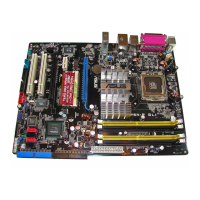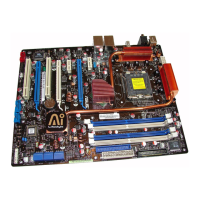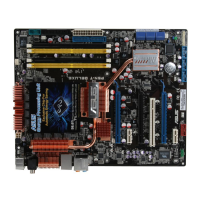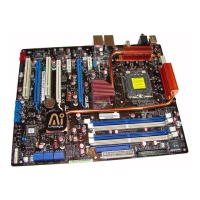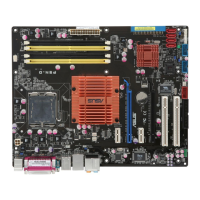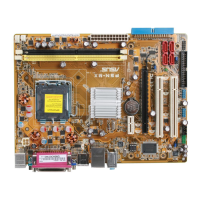Do you have a question about the Asus P5N73-AM and is the answer not in the manual?
Regulatory compliance statements from FCC and Canadian authorities.
Precautions for safe electrical handling and motherboard operation.
Explains the manual's organization and points to additional information sources.
Defines guide symbols, text formatting, and keyboard input conventions.
Details CPU, chipset, FSB, and DDR2 memory specifications.
Covers expansion slots, audio, storage, LAN, USB, and VGA specifications.
Lists ASUS proprietary features and BIOS characteristics.
Guides on motherboard orientation and securing it within the chassis.
Information on LGA775 socket, PnP cap, and warranty considerations.
Details steps for releasing the load lever and removing the PnP cap.
Describes positioning the CPU and securing the load plate and lever.
Instructions for installing the CPU heatsink and fan assembly.
Details securing the heatsink fasteners and connecting the CPU fan cable.
Step-by-step guide for removing the CPU heatsink and fan assembly.
Instructions on rotating fasteners clockwise after removal for resetting orientation.
Describes DDR2 DIMM sockets and supported memory configurations.
Lists tested and qualified DDR2 800MHz memory modules.
Lists qualified DDR2 667MHz memory modules.
Continues the list of qualified DDR2 667MHz memory vendors.
Lists qualified DDR2 533MHz memory modules.
Explains DIMM support types and guides DIMM installation.
Step-by-step instructions for safely removing a DIMM from its socket.
Guides on installing expansion cards into available slots.
Details configuring expansion cards and lists standard interrupt assignments (IRQ).
Shows IRQ assignments for external and internal devices.
Describes PCI, PCI Express x1, and PCI Express x16 slots and their uses.
Explains how to clear the CMOS settings using the CLRTC jumper.
Identifies and describes rear panel ports like PS/2, Parallel, LAN, USB, and Audio.
Details audio port functions and other rear panel ports like USB, VGA, Serial, PS/2.
Describes the floppy disk drive connector and its pinout.
Explains the IDE connector and configuration modes for devices.
Describes Serial ATA connectors and the system speaker connector.
Details fan connectors (CPU, Chassis, Power) and the S/PDIF digital audio connector.
Explains the 24-pin EATXPWR and 4-pin ATX12V power connectors.
Describes the CD audio connector and USB 2.0 connectors.
Describes connectors for front panel audio and chassis intrusion detection.
Details connectors for system power LED, HDD LED, power button, and reset button.
Introduces the chapter on changing system settings via BIOS Setup menus.
Lists utilities like ASUS Update, EZ Flash, AwardBIOS Flash, and CrashFree BIOS.
Provides steps and screenshots for updating the BIOS using the ASUS Update utility online.
Guides on updating the BIOS using a saved BIOS file.
Instructions for creating a bootable floppy disk in DOS, Windows XP, and Vista.
Explains the EZ Flash 2 utility for BIOS updates accessible via POST or BIOS setup.
Guides on updating BIOS using AwardBIOS Flash Utility in DOS mode.
Continues steps for AwardBIOS Flash Utility, including saving and confirming the update.
Instructions on how to save the current BIOS file using the AwardBIOS Flash Utility.
Explains the auto recovery tool for restoring BIOS from corrupted states.
Guides on restoring BIOS using the motherboard support DVD.
Explains how to enter the BIOS Setup utility using <Del> key or system restart.
Describes the BIOS menu layout, navigation keys, and main menu items.
Explains the legend bar, menu items, sub-menu indicators, and configuration fields.
Describes pop-up windows for configuration options and the general help text.
Allows setting system time, date, language, and floppy drive type.
Explains settings for IDE devices including PIO, UDMA, and access modes.
Describes auto-detected IDE parameters like Capacity, Cylinder, Head, Sector, Transfer Mode.
Covers configuration for Serial ATA devices, including access mode and parameters.
Details Landing Zone, Sector, HDD SMART monitoring, installed, and usable memory.
Details JumperFree settings for FSB, Memory Clock Mode, and Memory Ratio.
Covers FSB/Memory clock settings and initial memory timing parameters.
Details various memory timings and voltage adjustments.
Covers CPU settings like type, speed, thermal control, and virtualization.
Details Enhanced Intel SpeedStep and Chipset settings like frame buffer and display adapter.
Explains Plug & Play OS configuration settings.
Allows enabling/disabling onboard IDE channels and DMA transfer access.
Covers SATA operation modes, HD Audio, front panel audio type, and LAN settings.
Details parallel port settings and USB controller configurations.
Configures ACPI suspend states and APIC support.
Manages power loss behavior, power button events, and wake-up devices.
Configures RTC alarm, HPET support, and wake-on features for keyboard/mouse.
Displays hardware status like temperatures, fan speeds, and voltages; controls Q-Fan.
Sets the sequence for boot devices (e.g., Hard Disk, CDROM).
Configures removable drive assignments and boot behavior like Quick Boot.
Configures full screen logo display and error reporting behavior during boot.
Sets supervisor and user passwords to secure BIOS access and system boot.
Provides access to the ASUS EZ Flash 2 utility for BIOS updates.
Introduces the chapter focusing on the support DVD contents.
Discusses OS compatibility and how to run the motherboard support DVD.
Lists available device drivers on the support DVD for system activation.
Lists applications and software available on the support DVD.
Provides descriptions for utilities like PC Probe II, Acrobat Reader, Anti-Virus, and DirectX.
Guides on creating RAID driver disks for NVIDIA chipsets.
Lists available user manuals and provides ASUS contact details.
Provides motherboard specifications and a way to browse DVD contents graphically.
Displays the technical support request form and the support DVD file list.
Guides on creating and installing RAID driver disks for OS installation.
Introduces the appendix detailing CPU features supported by the motherboard.
Lists the requirements for using Intel SpeedStep Technology (EIST).
Guides on enabling and configuring Intel SpeedStep Technology in BIOS and OS.
Explains Intel Hyper-Threading Technology support and configuration.
| Non-ECC | Yes |
|---|---|
| Number of memory slots | 2 |
| Maximum internal memory | 4 GB |
| Processor socket | LGA 775 (Socket T) |
| Processor manufacturer | Intel |
| Number of EATX power connectors | 1 |
| Controller interface type | SATA 3 Gb/s |
| Controller 2nd interface type | UltraDMA 133/100/66 |
| USB 2.0 ports quantity | 4 |
| Firewire (IEEE 1394) ports | 0 |
| Audio chip | VIA VT1708B |
| Power source type | ATX |
| Audio output channels | 7.1 channels |
| Motherboard form factor | micro ATX |
| BIOS type | Award |
| BIOS memory size | 64 Mbit |
| Graphics card | GeForce 7050 |
| RAID levels | 0, 1 |
| Networking features | Fast Ethernet |
| Depth | 193 mm |
|---|---|
| Width | 244 mm |




